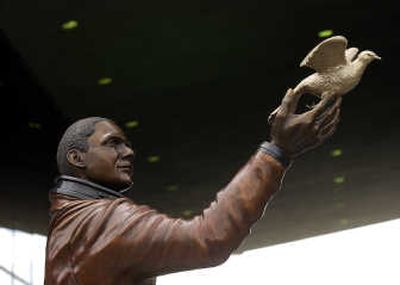Bronze statue honors astronaut Michael Anderson

Friday will be five years since Spokane’s own Lt. Col. Michael P. Anderson, U.S. Air Force, died with six other astronauts aboard the space shuttle Columbia when it broke up on re-entry over Texas, just 16 minutes before its scheduled landing and after a successful mission that lasted some 15 days, 22 hours and 20 minutes in space.
A meticulous scientist with an eye for details, it is likely he would appreciate the exactness of these particulars concerning the flight and its mission. He was always a good scientist in addition to being a good pilot.
The bronze statue in his memory by sculptor Dorothy Fowler – who, incidentally, is also a pilot – stands in the breezeway behind the INB Performing Arts Center in Riverfront Park. It shows him both kneeling and reaching to the heavens.
All who have spoken or written about him have noted that he was always pleased to lean down to children to assist and help inspire them. And also, it is a well-told story that at the age of 4, he announced that he would someday become an astronaut. Reaching down, reaching up – he dreamed it and he did it.
Though Anderson wasn’t born here, the Cheney High School graduate, the son of an Air Force man, did consider Spokane his home. It remains home for his parents Bobby “Andy” (a retiree from Avista Utilities) and Barbara Anderson.
On the first anniversary of the Columbia space shuttle’s plunge to earth, a group of Spokane citizens – from Avista Utilities, Sacred Heart Medical Center and African American community leaders – kicked off a fundraising campaign to build this monument for Anderson. Just 16 months later – on June 12, 2005 – the statue was dedicated at a ceremony which attracted some 300 people, including National Aeronautics and Space Agency officials, Anderson’s family, fellow astronauts and families of those who died with him aboard Columbia.
Jessie Wuerst, communications manager at Avista, said the group easily reached the $125,000 goal for the memorial. In fact, they over-subscribed the goal to the extent that discussions are under way about possibly endowing a scholarship fund in Anderson’s name. Together with the NAACP, they funded two scholarships last year.
They are also working with the Museum of Flight in Seattle and Seattle business people to raise $150,000 for a second Michael Anderson memorial statue, which will be the anchor for a new space exploration exhibit to be located there.
At the dedication of the statue in Riverfront Park, Fred Gregory, NASA deputy administrator, spoke of Anderson’s dedication to science – no surprise to Anderson’s Cheney High School science teacher Hal Sautter, who had remarked that his student could pretty much always be found in the lab and that a shoehorn was needed “to get him out of there.”
Anderson had been the payload commander aboard Columbia, in charge of 80 science experiments.
Anderson was also known as a man of faith. How fitting that his memorial statue shows him reaching skyward. It is reported that before the Columbia mission, he said to his minister that “if this thing doesn’t come out right, don’t worry about me. I’m just going on higher.”